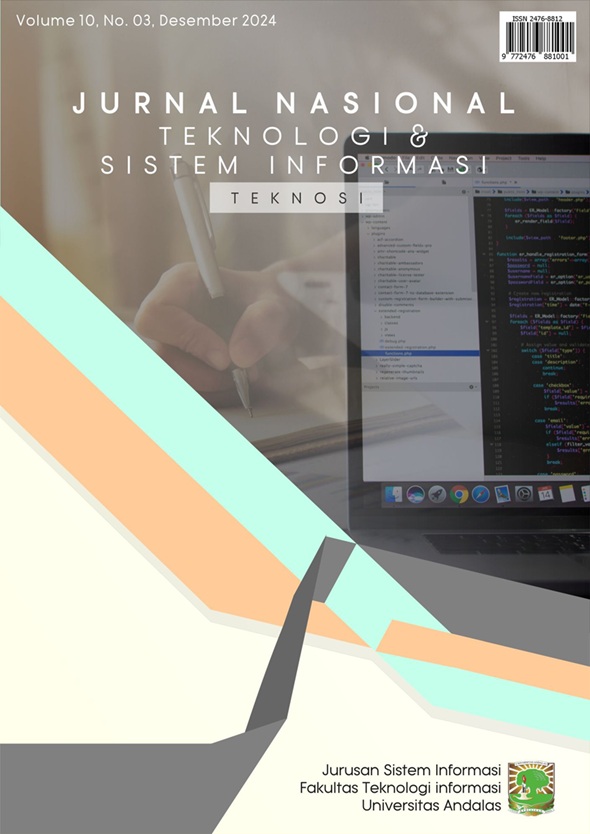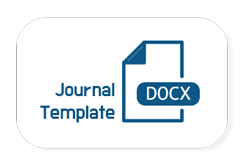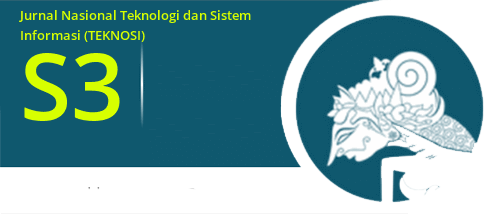Penerapan Deep Learning dengan Mekanisme Attention untuk Meningkatkan Performa Segmentasi Liver dan Tumor pada Citra CT Menggunakan ResUnet
DOI:
https://doi.org/10.25077/TEKNOSI.v10i3.2024.231-239Abstrak
Kanker hati merupakan salah satu penyebab kematian paling tinggi di dunia. Dalam mendeteksi kelainan pada hati perlu dilakukan segmentasi untuk mengambil bagian dari hati yang mengalami gangguan. Namun, metode segmentasi manual memakan waktu dan rawan kesalahan. Selain itu, metode tradisional juga sering kali kesulitan menangani variasi bentuk, ukuran, dan tekstur tumor, serta kualitas citra yang heterogen, sehingga mengurangi akurasi segmentasi. Oleh karena itu, penelitian ini mengusulkan penerapan model segmentasi menggunakan mekanisme Attention ResUnet, yang menggabungkan arsitektur residual dan konvolusi berbasis skip connection, ditingkatkan dengan attention untuk meningkatkan akurasi deteksi tumor. ResUnet dirancang untuk meningkatkan akurasi dan stabilitas segmentasi tumor dengan mengatasi masalah vanishing gradient dan meningkatkan kemampuan deteksi fitur kompleks. Dataset citra CT yang digunakan dalam penelitian ini dipra-pemroses melalui windowing untuk fokus pada rentang intensitas organ hati dan menghilangkan organ yang tidak penting. Hasil penelitian menunjukkan bahwa model Residual Unet dengan mekanisme Attention mampu meningkatkan performa segmentasi gambar CT hati dan tumor secara signifikan, mencapai akurasi 99.54% dan nilai Dice sebesar 95% pada segmentasi liver, serta akurasi 99.5% dan nilai Dice sebesar 90% pada segmentasi tumor. Penambahan modul Residual dan Attention secara efektif membantu model menangkap fitur yang relevan, khususnya dalam menangani lesi kompleks dan batas kabur, yang sering menjadi tantangan dalam segmentasi citra medis.Referensi
L. Han, Y. Chen, J. Li, B. Zhong, Y. Lei, and M. Sun, “Liver segmentation with 2.5D perpendicular UNets,” Computers and Electrical Engineering, vol. 91, May 2021, doi: 10.1016/j.compeleceng.2021.107118.
A. Aghamohammadi, R. Ranjbarzadeh, F. Naiemi, M. Mogharrebi, S. Dorosti, and M. Bendechache, “TPCNN: Two-path convolutional neural network for tumor and liver segmentation in CT images using a novel encoding approach,” Expert Syst Appl, vol. 183, Nov. 2021, doi: 10.1016/j.eswa.2021.115406.
P. Balakrishnan, B. Baskaran, S. Vivekanandan, P. Gokul, and B. Sathiya, “Liver segmentation using Mnet for cirrhosis,” Measurement: Sensors, vol. 31, Feb. 2024, doi: 10.1016/j.measen.2023.100986.
T. Liu et al., “Spatial feature fusion convolutional network for liver and liver tumor segmentation from CT images,” Med Phys, vol. 48, no. 1, pp. 264–272, Jan. 2021, doi: 10.1002/mp.14585.
H. Li and B. Liang, “Liver Tumor Computed Tomography Image Segmentation Based on an Improved U-Net Model,” Applied Sciences (Switzerland), vol. 13, no. 20, Oct. 2023, doi: 10.3390/app132011283.
M. Rela, N. R. Suryakari, and P. R. Reddy, “Liver Tumor Segmentation and Classification: A Systematic Review,” in Proceedings of 2020 IEEE-HYDCON International Conference on Engineering in the 4th Industrial Revolution, HYDCON 2020, Institute of Electrical and Electronics Engineers Inc., Sep. 2020. doi: 10.1109/HYDCON48903.2020.9242757.
W. Thong, S. Kadoury, N. Piché, and C. J. Pal, “Convolutional networks for kidney segmentation in contrast-enhanced CT scans,” Comput Methods Biomech Biomed Eng Imaging Vis, vol. 6, no. 3, pp. 277–282, May 2018, doi: 10.1080/21681163.2016.1148636.
L. Sun, L. Jiang, M. Wang, Z. Wang, and Y. Xin, “A Multi-Scale Liver Tumor Segmentation Method Based on Residual and Hybrid Attention Enhanced Network with Contextual Integration,” Sensors, vol. 24, no. 17, Sep. 2024, doi: 10.3390/s24175845.
Y. Zhou, Q. Kong, Y. Zhu, and Z. Su, “MCFA-UNet: Multiscale Cascaded Feature Attention U-Net for Liver Segmentation,” IRBM, vol. 44, no. 4, Aug. 2023, doi: 10.1016/j.irbm.2023.100789.
J. Ma, M. Xia, Z. Ma, and Z. Jiu, “MDAU-Net: A Liver and Liver Tumor Segmentation Method Combining an Attention Mechanism and Multi-Scale Features,” Applied Sciences (Switzerland), vol. 13, no. 18, Sep. 2023, doi: 10.3390/app131810443.
N. Alalwan, A. Abozeid, A. A. A. ElHabshy, and A. Alzahrani, “Efficient 3D Deep Learning Model for Medical Image Semantic Segmentation,” Alexandria Engineering Journal, vol. 60, no. 1, pp. 1231–1239, Feb. 2021, doi: 10.1016/j.aej.2020.10.046.
W. Yu, M. Wang, Y. Zhang, and L. Zhao, “Reciprocal cross-modal guidance for liver lesion segmentation from multiple phases under incomplete overlap,” Biomed Signal Process Control, vol. 88, Feb. 2024, doi: 10.1016/j.bspc.2023.105561.
L. H. Shehab, O. M. Fahmy, S. M. Gasser, and M. S. El-Mahallawy, “An efficient brain tumor image segmentation based on deep residual networks (ResNets),” Sep. 01, 2021, King Saud University. doi: 10.1016/j.jksues.2020.06.001.
P. Agrawal, N. Katal, and N. Hooda, “Segmentation and classification of brain tumor using 3D-UNet deep neural networks,” International Journal of Cognitive Computing in Engineering, vol. 3, pp. 199–210, Jun. 2022, doi: 10.1016/j.ijcce.2022.11.001.
R. A. Zeineldin, M. E. Karar, J. Coburger, C. R. Wirtz, and O. Burgert, “DeepSeg: deep neural network framework for automatic brain tumor segmentation using magnetic resonance FLAIR images,” Int J Comput Assist Radiol Surg, vol. 15, no. 6, pp. 909–920, Jun. 2020, doi: 10.1007/s11548-020-02186-z.
W. R. Khan et al., “A Hybrid Attention-Based Residual Unet for Semantic Segmentation of Brain Tumor,” Computers, Materials and Continua, vol. 76, no. 1, pp. 647–664, 2023, doi: 10.32604/cmc.2023.039188.
F. J. Díaz-Pernas, M. Martínez-Zarzuela, D. González-Ortega, and M. Antón-Rodríguez, “A deep learning approach for brain tumor classification and segmentation using a multiscale convolutional neural network,” Healthcare (Switzerland), vol. 9, no. 2, Feb. 2021, doi: 10.3390/healthcare9020153.
H. Fu et al., “HMRNet: High and Multi-Resolution Network With Bidirectional Feature Calibration for Brain Structure Segmentation in Radiotherapy,” IEEE J Biomed Health Inform, vol. 26, no. 9, pp. 4519–4529, Sep. 2022, doi: 10.1109/JBHI.2022.3181462.
W. Wang et al., “PVT v2: Improved baselines with Pyramid Vision Transformer,” Comput Vis Media (Beijing), vol. 8, no. 3, pp. 415–424, Sep. 2022, doi: 10.1007/s41095-022-0274-8.
C.-H. Huang, H.-Y. Wu, and Y.-L. Lin, “HarDNet-MSEG: A Simple Encoder-Decoder Polyp Segmentation Neural Network that Achieves over 0.9 Mean Dice and 86 FPS,” Jan. 2021, [Online]. Available: http://arxiv.org/abs/2101.07172
M. Y. Ansari, Y. Yang, P. K. Meher, and S. P. Dakua, “Dense-PSP-UNet: A neural network for fast inference liver ultrasound segmentation,” Comput Biol Med, vol. 153, Feb. 2023, doi: 10.1016/j.compbiomed.2022.106478.
A. M. Khan, A. Ashrafee, F. S. Khan, Md. B. Hasan, and Md. H. Kabir, “AttResDU-Net: Medical Image Segmentation Using Attention-based Residual Double U-Net,” Jun. 2023, [Online]. Available: http://arxiv.org/abs/2306.14255
P. Bilic et al., “The Liver Tumor Segmentation Benchmark (LiTS),” Jan. 2019, doi: 10.1016/j.media.2022.102680.
O. I. Alirr, “Deep learning and level set approach for liver and tumor segmentation from CT scans,” J Appl Clin Med Phys, vol. 21, no. 10, pp. 200–209, Oct. 2020, doi: 10.1002/acm2.13003.
M. A. Djohar et al., “Liver Segmentation Using Convolutional Neural Network Method with U-Net Architecture,” Journal Of Informatics And Telecommunication Engineering, vol. 6, no. 1, pp. 221–234, Jul. 2022, doi: 10.31289/jite.v6i1.6751.
J. Cha and J. Jeong, “Improved U-Net with Residual Attention Block for Mixed-Defect Wafer Maps,” Applied Sciences (Switzerland), vol. 12, no. 4, Feb. 2022, doi: 10.3390/app12042209.
M. Hasnain, M. F. Pasha, I. Ghani, M. Imran, M. Y. Alzahrani, and R. Budiarto, “Evaluating Trust Prediction and Confusion Matrix Measures for Web Services Ranking,” IEEE Access, vol. 8, pp. 90847–90861, 2020, doi: 10.1109/ACCESS.2020.2994222.
O. Sule and S. Viriri, “Enhanced Convolutional Neural Networks for Segmentation of Retinal Blood Vessel Image,” in 2020 Conference on Information Communications Technology and Society, ICTAS 2020 - Proceedings, Institute of Electrical and Electronics Engineers Inc., Mar. 2020. doi: 10.1109/ICTAS47918.2020.233996.
A. Rehman, M. A. Butt, and M. Zaman, “Attention Res-UNet: Attention Residual UNet with Focal Tversky Loss for Skin Lesion Segmentation,” International Journal of Decision Support System Technology, vol. 15, no. 1, Dec. 2022, doi: 10.4018/IJDSST.315756.
Y. A. Ayalew, K. A. Fante, and M. A. Mohammed, “Modified U-Net for liver cancer segmentation from computed tomography images with a new class balancing method,” BMC Biomed Eng, vol. 3, no. 1, Dec. 2021, doi: 10.1186/s42490-021-00050-y.
J. Ma, Y. Deng, Z. Ma, K. Mao, and Y. Chen, “A Liver Segmentation Method Based on the Fusion of VNet and WGAN,” Comput Math Methods Med, vol. 2021, 2021, doi: 10.1155/2021/5536903.
Unduhan
Telah diserahkan
Diterima
Diterbitkan
Cara Mengutip
Terbitan
Bagian
Lisensi
Hak Cipta (c) 2024 Jurnal Nasional Teknologi dan Sistem Informasi

Artikel ini berlisensiCreative Commons Attribution-ShareAlike 4.0 International License.
Hak cipta untuk artikel ini ditransfer ke Jurnal Nasional Teknologi dan Sistem Informasi (TEKNOSI) jika dan ketika artikel diterima untuk publikasi. Yang bertanda tangan di bawah ini dengan ini mentransfer setiap dan semua hak di dalam dan ke kertas termasuk tanpa batasan semua hak cipta untuk TEKNOSI. Yang bertanda tangan di bawah ini dengan ini menyatakan dan menjamin bahwa makalah tersebut asli dan bahwa ia adalah pembuat makalah, kecuali untuk bahan yang secara jelas diidentifikasi sebagai sumber aslinya, dengan pemberitahuan izin dari pemilik hak cipta jika diperlukan. Yang bertanda tangan di bawah ini menyatakan bahwa ia memiliki kekuatan dan wewenang untuk membuat dan melaksanakan penugasan ini.
Kami menyatakan bahwa:
- Makalah ini belum diterbitkan dalam bentuk yang sama di tempat lain.
- Makalah ini tidak akan dikirimkan di tempat lain untuk publikasi sebelum penerimaan/penolakan oleh Jurnal ini
- Izin hak cipta diperoleh untuk materi yang diterbitkan di tempat lain dan yang memerlukan izin ini untuk reproduksi.
Selanjutnya, Saya/kami dengan ini mentransfer hak publikasi yang tidak terbatas dari makalah yang disebutkan di atas secara keseluruhan kepada TEKNOSI. Transfer hak cipta mencakup hak untuk mereproduksi dan mendistribusikan artikel, termasuk cetak ulang, terjemahan, reproduksi foto, mikroform, bentuk elektronik (offline, online) atau reproduksi lain yang serupa.
Penulis yang sesuai menandatangani dan menerima tanggung jawab untuk merilis materi ini atas nama setiap dan semua penulis bersama. Perjanjian ini harus ditandatangani oleh setidaknya salah satu penulis yang telah memperoleh persetujuan dari rekan penulis jika berlaku. Setelah pengajuan perjanjian ini ditandatangani oleh penulis yang sesuai, perubahan kepengarangan atau dalam urutan penulis yang tercantum tidak akan diterima.
Hak / Syarat dan Ketentuan yang dipertahankan :
- Penulis memiliki semua hak kepemilikan dalam setiap proses, prosedur, atau artikel manufaktur yang dijelaskan dalam Karya ini.
- Penulis dapat mereproduksi atau mengotorisasi orang lain untuk mereproduksi karya ini atau karya turunannya untuk penggunaan pribadi penulis atau untuk penggunaan perusahaan, dengan ketentuan bahwa sumber dan menyatakan hak cipta dimiliki TEKNOSI, salinan tidak digunakan dengan cara apa pun yang menyiratkan pengesahan TEKNOSI atas suatu produk atau layanan dari pihak mana pun, dan salinannya sendiri tidak ditawarkan untuk dijual.
- Meskipun penulis diizinkan untuk menggunakan kembali semua atau sebagian dari karya ini dalam karya lain, ini tidak termasuk mengabulkan permintaan pihak ketiga untuk mencetak ulang, menerbitkan ulang, atau jenis penggunaan ulang lainnya.














